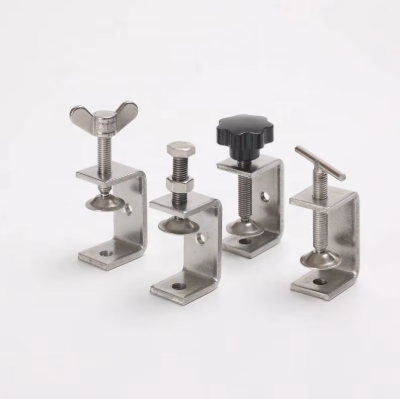العوامل الرئيسية لاختيار المكبس المناسب للخراطيم المشبك
الاستخدام المقصود وبيئة التطبيق
يبدأ اختيار المشبك المناسب للخرطوم بمعرفة المهمة التي يجب القيام بها بدقة. تتطلب الإعدادات المختلفة حلولاً مختلفة سواء كنا نتحدث عن السيارات أو أنابيب المياه في المنازل أو المعدات الصناعية الثقيلة. ما قد يعمل بشكل ممتاز في موقف ما قد يفشل تمامًا في آخر بسبب عوامل مثل التغيرات في درجة الحرارة أو التعرض لمواد كيميائية قاسية أو التقلبات في الضغط داخل الأنظمة. خذ على سبيل المثال مشابك السيارات، فهي تواجه بانتظام درجات حرارة وضغوطًا عالية ناتجة عن comparments المحرك. في الوقت نفسه، تحتاج المشابك التي تتعامل مع المواد الكيميائية إلى مواد خاصة تتحمل التآكل على المدى الطويل. يعتمد معظم المختصين على المبادئ التوجيهية التي وضعتها جهات مثل SAE أو ASTM عند اتخاذ قرارات الشراء. هذه المعايير ليست مجرد أوراق رسمية، بل إنها توفر في الواقع المال والمتاعب على المدى الطويل. الشخص الذي يخصص الوقت لفهم تركيبته الخاصة بدقة سيجد مشبكًا يثبت متانته يومًا بعد يوم دون أن يفلت عندما تكون الحاجة إليه في ذروتها.
توافق المواد ومتانة
من المهم جدًا التأكد من توافق المواد التي تلامس المشابك لمنع الفشل المبكر. تأتي الخراطيم بأنواع مختلفة من المواد هذه الأيام مثل المطاط والبلاستيك وحتى بعض المعادن، وكل نوع يحتاج إلى نوع معين من المشابك للعمل بشكل صحيح. خذ على سبيل المثال مشابك الفولاذ المقاوم للصدأ، فهي تعمل بشكل جيد مع خراطيم السيليكون لأن الفولاذ المقاوم للصدأ يدوم لفترة أطول ولا يصدأ بسهولة. عند العمل في ظروف قاسية مثل المياه المالحة أو المواد الكيميائية، تميل مكونات الألومنيوم إلى التدهور بسرعة أكبر مقارنة بنظيراتها المصنوعة من الفولاذ المقاوم للصدأ. ولهذا يفضل الكثير من المحترفين استخدام الفولاذ المقاوم للصدأ عندما تكون الموثوقية مهمة. اختيار التوليفات الصحيحة من المواد تحدث فرقًا كبيرًا في عمر نظام الخرطوم وكفاءة أدائه يومًا بعد يوم.
متطلبات القطر وقوة الشد
إن اختيار قطر الخرطوم المناسب أمرٌ بالغ الأهمية عند تحديد مقاس المشبك الصحيح. إذا لم يكن المشبك مناسباً تماماً، سواء كان كبيراً جداً أو ضيقاً لدرجة تكاد لا تدخل فيها، فسوف نواجه مشكلة التسرب أو حتى تلف الخراطيم. عندما تكون المشابك ذات الأحجام المناسبة، فإنها تحافظ على الإغلاق المحكم دون الضغط بقوة مفرطة. إن درجة الشد مهمة جداً في هذا السياق. إن استخدام قوة مفرطة قد يؤدي في النهاية إلى تمزق الخرطوم بمرور الوقت، لكن إذا لم يتم شدها بشكل كافٍ، فسوف تعاود التسرب مرة أخرى. وللحصول على أفضل النتائج، استخدم مفتاح العزم كلما أمكن ذلك. فهو يساعد على توزيع الضغط بالتساوي على طول المشبك، مما يجعل كل من الخرطوم والمشبك lasts أطول مما قد يحققه التخمين العشوائي.
المعايير والشهادات
للحفاظ على الأمان وضمان التشغيل السليم، يجب أن تتوافق مشابك الحلمة مع معايير صناعية محددة. تضع منظمات مثل ISO وASTM وDIN هذه المعايير بحيث يعرف المصنعون ما يجب أن تتحمله مشابكهم تحت ظروف مختلفة. عندما تحصل المشبك على شهادة من إحدى هذه الجهات، فهذا يعني أن شخصًا ما قام بتجربته بالفعل في ظروف قاسية قبل بيعه للعملاء. إن الاطلاع على الوثائق التي يقدمها الموردون ليس مجرد بيروقراطية، بل يخبرنا ما إذا كانت المشبك التي نشتريها تناسب بالفعل ما نحتاجه لمهنتنا الخاصة. سيكون من الحكمة أن يلتزم أي شخص يعمل على التركيبات المهمة باستخدام القطع المعتمدة بدلًا من البدائل الأرخص التي قد تفشل عندما ترتفع الضغوط. إن التكلفة الإضافية تؤتي ثمارها في شعور الطمأنينة الناتج عن معرفة أن الفشل لن يحدث بسبب مكونات غير مطابقة للمواصفات.
أنواع الخراطيم مكابس ومجالات تطبيقها
مقابس برغي / دودة: مرونة في السيارات والسباكة
تُعتبر مشابك التروس اللولبية أو الدودية من أكثر الخيارات مرونة عندما يتعلق الأمر بحلول تثبيت الخراطيم. ما يميزها هو تصماعدها القابل للتعديل، والذي يتيح للمستخدمين ضبط درجة إحكام المشبك حول الأجزاء التي تحتاج إلى تثبيت. وعمومًا، تتكون هذه المشابك من شريط معدني متصل بآلية مسمار، مما يمنح المستخدمين تحكمًا جيدًا في مدى إحكام التثبيت المطلوب. هذا هو السبب في أن الميكانيكيين وفنيي السباكة يميلون إلى استخدامها بشكل متكرر. عند العمل على السيارات أو إصلاح الأنابيب في المنازل، هناك العديد من المواقف التي يحتاج فيها الشخص إلى تعديل أو إزالة الخراطيم عدة مرات أثناء العمل. يعلم معظم المهنيين أن هذه المشابك تساعد في الحفاظ على ضغط مستقر ومنع أي تسرب أو ترخي، وهو أمر بالغ الأهمية في كل من ورش إصلاح السيارات وتركيبات السباكة. ولكن هناك نقطة واحدة لا ينبغي نسيانها: لا تقم بإحكام المسمار بشكل مفرط حتى لا تضر الخرطوم نفسه.
T- صمولة مقابس لأنظمة الضغط العالي
تُنجز وصلات البرغي على شكل حرف T المهمة في تلك المواقف ذات الضغط العالي حيث لا يُقبل أقل من ختم محكم. يعمل النظام بأكمله بفضل ذلك النظام المكون من البرغي والمقص الذي يوزع الضغط بشكل متساوٍ على طول نقطة اتصال الخرطوم. ولذلك يعتمد الميكانيكيون والمهندسين في القطاعات الصعبة مثل صناعة السيارات والطيران على هذه الوصلات بشكل كبير. ما الذي يميز أربطة البرغي على شكل T؟ إنها تتحمل الضغوط الجادة دون أن تنكسر أو ترتخي، وهو ما لا تستطيع الوصلات العادية تحمله بعد الاستخدام المتكرر. وقد أثبتت الاختبارات مرارًا وتكرارًا أن نماذج البرغي على شكل T تظل ثابتة حتى عند دفعها إلى ما بعد الحدود التي يمكن أن تتحملها الوصلات القياسية ذات الزنبركات أو التروس اللولبية. ولأي شخص يعمل مع أنظمة نقل السوائل الحرجة، فهذا يعني تسربات أقل، وانخفاض وقت التوقف، وأخيرًا تحقيق هوامش أمان أفضل في العمليات.
مكابس الأذن: تركيب سريع في المساحات الضيقة
تم تصميم مشابك الأذن خصيصًا لتكون سهلة التركيب، خاصة عند العمل في مناطق مزدحمة لا تستطيع الأدوات القياسية الوصول إليها. ما يميز هذه المشابك هي تلك الأذن المميزة التي يتم تشكيلها أثناء التصنيع، مما يخلق قبضة قوية حول الخراطيم. تعمل هذه الميزة بشكل ممتاز في المواقف التي يكون فيها المكان ضيقًا للغاية، فكر في أنظمة التبريد في السيارات أو تركيب خطوط الوقود حيث يُعد كل إنش مهمًا. بالإضافة إلى ذلك، تصميمها المسطح يعني أن يمكن للميكانيكيين تركيبها بسهولة، مما يقلل من الوقت والجهد المبذول. تجعل هذه المزايا من مشابك الأذن المفضلة لدى الفنيين الذين يحتاجون إلى إنجاز المهام بسرعة دون التفريط في جودة الوصلات.
مكابس الإطلاق السريع للتعديلات المتكررة
تتميز مشابك الإطلاق السريع عندما تحدث التعديلات بشكل متكرر أو تكون هناك حاجة للصيانة بشكل دوري. تعمل هذه المشابك بشكل ممتاز في الأماكن مثل مصانع معالجة الأغذية وتركيبات أنظمة التدفئة وتكييف الهواء، حيث يحتاج العمال إلى فصل الأجزاء بسرعة وإعادة تركيبها بنفس السرعة. تكمن ميزة هذه المشابك في سهولة تشديدها أو ترخيتها، مما يعني أن التعديلات يمكن إجراؤها بسرعة دون التأثير على ختم الوصلات. وعند استخدام هذه المشابك، من المفيد معرفة الطريقة الصحيحة لتركيبها. يؤدي القيام بذلك إلى الحفاظ على سير العمليات بسلاسة وتجنب المشاكل الناتجة عن تشديدها بشكل مفرط أو تعديلها بطريقة خاطئة منذ البداية.
المقابس المعدنية مقابل البلاستيكية: المزايا والعيوب
مقابس الفولاذ المقاوم للصدأ لمكافحة التآكل
مقاومة التآكل التي تتمتع بها مشابك الفولاذ المقاوم للصدأ تجعلها مميزة مقارنة بالمنافسين، خاصة في الظروف القاسية. هذه المشابك تمنع تشكّل الصدأ وتستمر لفترة أطول بكثير من الخيارات الأخرى، وهو ما يفسر سبب استخدامها في أماكن مثل السفن ومصانع الكيماويات. تشير الاختبارات الميدانية إلى أنها تتحمل بفعالية رش الملح والكيماويات الصناعية ودرجات الحرارة التي تذيب المعادن الأقل جودة. فكر فيما يحدث على طول السواحل أو على متن السفن التي تواجه باستمرار تسرب المياه المالح. تبدأ المشابك العادية بالتدهور خلال أشهر بينما تستمر المشابك المصنوعة من الفولاذ المقاوم للصدأ في الأداء بشكل جيد على مدار السنين. حقيقة أنها مقاومة للصدأ تعني أن المهندسين يمكنهم الاعتماد على اتصال محكم وطويل الأمد في المواقف التي قد تؤدي فيها أيّة أعطال في المعدات إلى مشاكل كبيرة على المدى الطويل.
خيارات الألمنيوم والنحاس للاحتياجات الخفيفة الوزن
عندما يُعد الوزن عاملاً مهماً لكن لا يمكن التفريط في القوة، فإن مشابك الحلمة المصنوعة من الألومنيوم والنحاس توفر خيارات رائعة. فكلا هذين المادتين أخف بكثير من الصلب، مما يجعلهما مثاليين للاستخدام في أشياء مثل الطائرات أو السيارات، حيث يؤدي تقليل الوزن إلى تحسين الأداء بشكل ملحوظ. خذ قطاع الطيران مثالاً، لا يرغب أحد في حمل وزن إضافي أثناء الطيران لأنه يستهلك المزيد من الوقود بسرعة. ولذلك يفضل الطيارون والمهندسون استخدام مشابك أخف وزناً، حتى تظل طائراتهم فعالة أثناء الطيران. بالإضافة إلى ذلك، يميل الألومنيوم والنحاس إلى أن تكون تكلفتهما أقل مقارنة بنظيراتهما المصنوعة من الفولاذ المقاوم للصدأ. إذن، لأي شخص يعمل ضمن ميزانية محدودة لكنه ما زال بحاجة إلى شيء متين يتحمل الاستخدام الجاد، فإن هذه المشابك المعدنية تمثل نقطة التوازن المثالية بين السعر والأداء.
مقاطع بلاستيكية في البيئات الكهربائية والكيميائية
تعمل المشابك البلاستيكية بشكل جيد حقًا في المواقف التي تحتاج إلى خصائص عزل جيدة أو عند التعامل مع مواد كيميائية قاسية. المشابك المعدنية تُوصّل الكهرباء، لذا فإن المشابك البلاستيكية تمثّل خيارًا أفضل بكثير في الإعدادات الكهربائية التي لا نرغب فيها في مرور تيار كهربائي عبر المشبك نفسه. ولكن هناك عيب. البلاستيك ليس قويًا بقدر المعدن، مما يعني أن هذه المشابك ليست مناسبة للمهام الشاقة. فهي تعمل بشكل أفضل في التطبيقات الأخف حيث لا تتعرض الحوافيز لضغط أو إجهاد شديد. فكّر في أشياء مثل معدات معالجة كيميائية صغيرة الحجم. هنا، تتميز المشابك البلاستيكية بأنها تقاوم العديد من المواد الكيميائية التي قد تؤدي في الواقع إلى تآكل المشابك المعدنية مع مرور الوقت.
نصائح التركيب للحصول على أداء مثالي
تجنب الضغط الزائد والتلف في الخرطوم
التشديد المفرط هو خطأ شائع يؤدي إلى تلف الخراطيم. إن الضغط الزائد أثناء التركيب يسبب في كثير من الأحيان فشلاً في المادة، خاصة مع الخراطيم ذات الجدران الرقيقة التي تميل إلى التشقق أو التمزق تحت الضغط. للحصول على درجة التوتر الصحيحة، من المهم معرفة ما يناسب كل نوع من المواد والنوع المختلف من الخراطيم. يتفق الخبراء عمومًا على أن التشديد بدرجة كافية دون أن يكون شديدًا بشكل مفرط هو ما يُحدث الفرق في الحفاظ على جودة الخرطوم وزيادة عمره الافتراضي. التركيب الصحيح يعني استخدام الأدوات المناسبة والقوة الملائمة التي تضمن ثبات الوصلات دون التأثير على الخرطوم نفسه. القاعدة الأساسية التي يُنصح باتباعها هي: إذا شعرت بأنها مشدودة جدًا، فهي على الأرجح كذلك.
الوضع الصحيح لتوزيع الضغط بالتساوي
يعتبر وضع كابح الحلمة في المكان الصحيح أمراً بالغ الأهمية لتوزيع الضغط بشكل صحيح على طول الحلمة. عندما يتم توزيع الضغط بشكل دقيق، يؤدي الكابح وظيفته بكفاءة أكبر في منع التسرب والحفاظ على الوصلات محكمة. يجد معظم الناس أن أفضل نتيجة تتحقق عندما يوضع الكابح على بعد ربع بوصة من نهاية الحلمة لتجنب انزلاقه. سيؤكد المهندسون على ضرورة أن يكون الكابح في وضع مستقيم على الحلمة دون أن يكون ملتوياً أثناء شدّه. لقد شهدنا العديد من حالات التركيب الفاشلة التي تعود ببساطة إلى تجاهل هذه الخطوة. ما هي الفائدة المترتبة على ذلك؟ إن الكابح الموضوع بدقة يدوم لفترة أطول ويحافظ على سلامة الحلمة تحت مختلف الظروف دون أن ينكسر بشكل غير متوقع.
اختبار التسرب بعد التركيب
إن اكتشاف التسرب بعد التركيب يُعد أمراً مهماً حقاً إذا أردنا الحفاظ على الأنظمة آمنة وتعمل بشكل صحيح. عندما نكتشف هذه المشاكل الصغيرة مبكراً، نمنعها من أن تتحول إلى مشاكل أكبر في المستقبل. يجد معظم الناس أن اختبارات الضغط فعالة، على الرغم من أن أحياناً مجرد فحص دقيق للمفاصل يمكن أن يكشف عن مشاكل لا يلاحظها أحد آخر. تشير لوائح OSHA بشكل واضح إلى ضرورة إجراء فحوصات دورية لاكتشاف التسرب كجزء من إجراءات الصيانة السليمة. الالتزام بهذه القواعد ليس فقط من أجل الورق الرسمي، بل هو منطقي عملياً أيضاً. الأنظمة التي تُختبر بانتظام تميل إلى أن تكون أطول عمراً وأداءً أفضل بشكل عام، مما يوفّر المال على المدى الطويل رغم التكلفة الأولية للاختبار.
الأسئلة الشائعة
ما العوامل التي يجب أن أأخذها في الاعتبار عند اختيار مقيد خرطوم؟
عند اختيار مقيد خرطوم، اأخذ في الاعتبار الاستخدام المقصود والبيئة التطبيقية، توافق المواد ومتانتها، القطر الدقيق ومتطلبات قوة الشد، والالتزام بالمعايير والشهادات.
هل تكون مقابس الخراطيم الفولاذية الصدأ مناسبة لجميع البيئات؟
تُعتبر مقاطع خراطيم الستانلس ستيل مناسبة بشكل خاص للبيئات القاسية بسبب مقاومتها للتآكل، وهي مفيدة بشكل خاص في الصناعات البحرية ومعالجة الكيماويات حيث يكون التعرض للأملاح والكيماويات شائعًا.
لماذا تعتبر مقاطع الإفراج السريع مفيدة؟
توفر مقاطع الإفراج السريع فوائد للاستخدامات التي تتطلب تعديلات أو صيانة متكررة، مما يوفر مرونة تشغيلية وسهولة الوصول دون المساس بالموثوقية.
كيف يمكنني تجنب شد مقاطع الخراطيم بشكل مفرط؟
لتجنب الشد الزائد، استخدم أدوات مناسبة مثل عزم المفتاح، واتبع إرشادات التوتر الخاصة بنوع ومادة الخرطوم، وتأكد من الحصول على تركيب محكم ولكن ليس مشدودًا بشكل مفرط.

